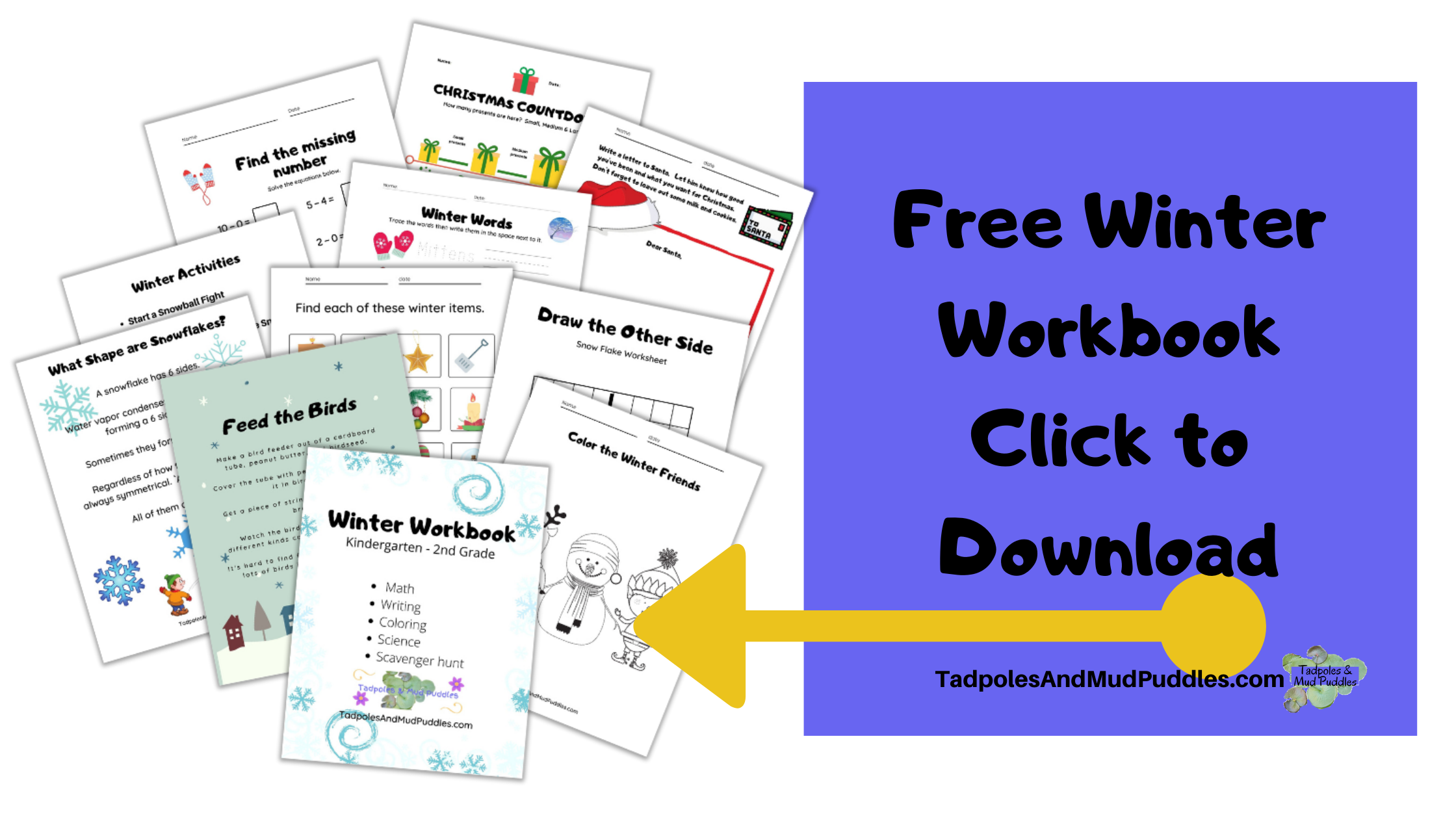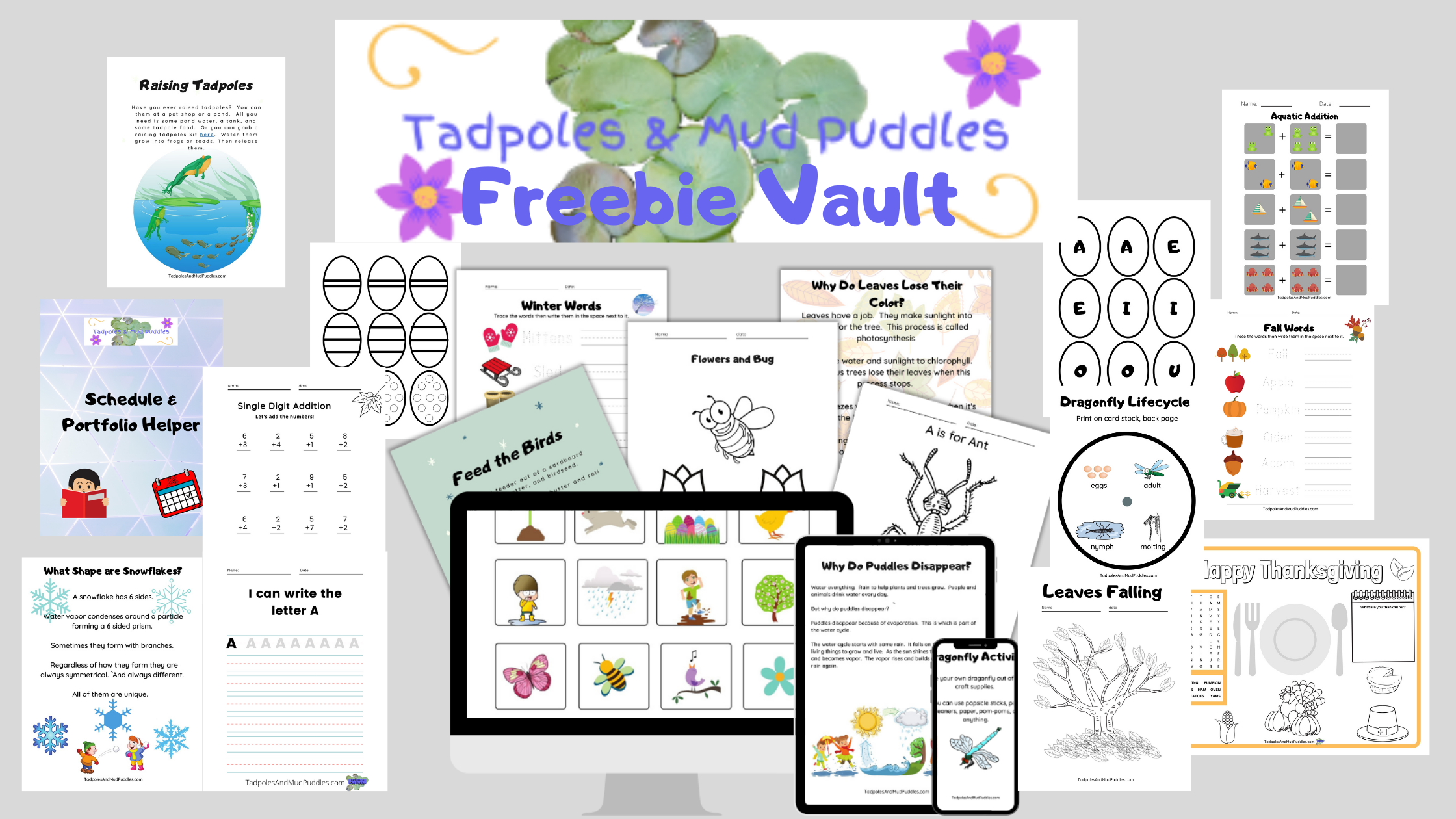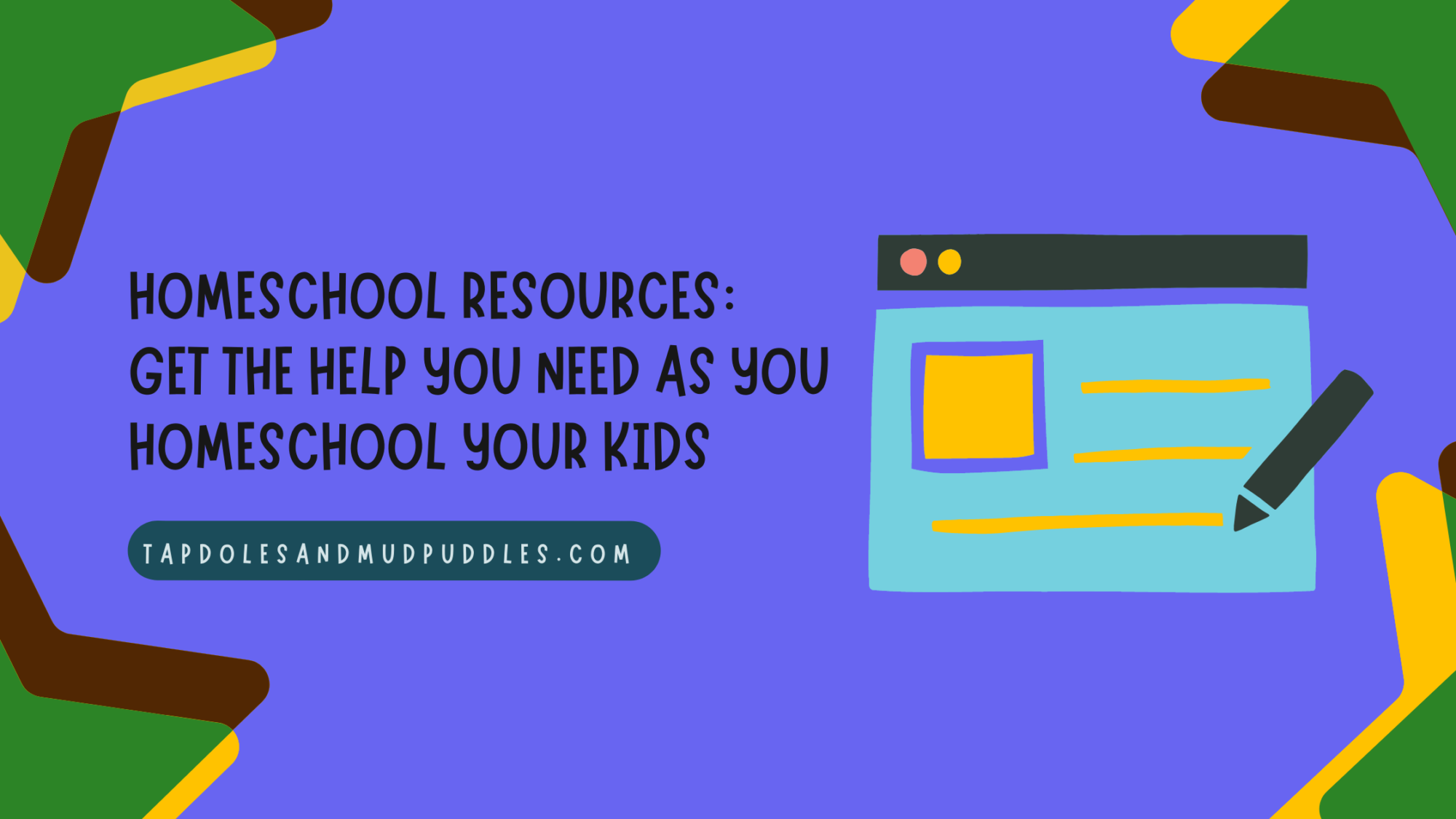If you’ve clicked here you’re probably wondering if you’re capable of homeschooling your kids or just finding out more resources for your kid(s). The answer is a resounding yes. It’s hard. But it’s worth every single minute. Learn from us as we grow and homeschool. This is your one-stop shop for homeschool resources. Check out these posts to get started.

Homeschooling 101
- How to Homeschool When You Have No Clue Where to Start
- Homeschooling Learning Style, How Do You Teach?
- The Ultimate Guide to Homeschooling an Active Kid
Reading Resources
- Encourage Early Reading with These 5 Types of Books
- Alphabet Workbook Details
- Free Alphabet Activities and Workbooks
Writing Resources
Math Resources
Science Resources
Activities
- Legos for Learning, Why You Need a Big Bin of Legos
- Learning and Playing with a Frog
- Mud Play Activities
- For the Boy Moms Who Don’t Like Bugs
Field Trips
Please grab access to the freebie vault and get your hands on all of the free resources available to you. We’ve got worksheets, calendars, and activities all free. Click the picture to sign up for your freebies.

I’m working to make finding homeschooling help easier here. But I’d love some feedback about homeschool resources. If you fill out the survey I’ll enter you into the homeschool bundle drawing. You’ll get your choice of resources from the shop for free.
What grade are your children in? You can find resources for each grade here. We’ll be adding new ones each year as we go through the grade ourselves.
Or you can browse the post below. You can find topic ideas; our favorite resources, activities, and projects; and grade work.
-
V is for Virtues
Virtues are caught and not always taught. It’s also built over the years. Chivalry isn’t dead. It’s just not taught anymore. It should be. A good man protects those who need help. Provides for their family. Leads their family unit. And won’t shy away from hard work. By the way, this post is part of…
-
U is for Uniqueness
All children should know that they are unique and to be proud of who they are. Celebrate the uniqueness of your children. Develop their own personality and character traits. They should be confident in their own uniqueness. It’s good to choose good people to be around you and let those who aren’t go. We can’t…
-
T is for Character Traits
Homeschooling can develop some fantastic kids but as a parent, I need to develop characteristics in my child to build an amazing adult. As a boy, he needs healthy risk: to test his limits and safe adventure. He should be trustworthy, to be responsible, should expect respect, and know how to show respect. He needs…
-
S is for Science Projects
Science projects are so much fun. They are one of Aiden’s favorites. We love hands-on science. Aiden got a microscope for Christmas along with a bunch of prepared slides. There’s so much you can see. Whether you’re learning about an inventor and building your own invention or sticking your fingers in something gross and gooey,…
-
R is for Repeating
Repeating is the key to memory. If you repeat, you will remember. Practice the times tables every day for a month and multiplication gets a lot easier. Run through a list of dates and your historic facts are in there. Practice every day and pretty soon there isn’t much you can’t do. By the way,…
-
Q is for Quiet Time
Quiet is a skill. I know I need to cultivate it in my son. Either his legs are moving or his mouth is running a mile a minute. His goal is to be the loudest all the time. He’s never realized that quiet is a good thing. Knowing what benefits come with quiet play or…
-
P is for Pretend Play
Play is learning. Pretend play gets a bad rap with us parents. Doing what you ask when you ask is often not without play. Play is soothing, it helps work out tough subjects, and it can be used in role-play in real life. Turn a chore into a game and it will get done, fast. …
-
O is for Open-ended Days
Open-ended days offer time for spontaneity. Is it a bad day for focus? Let’s take a trip to the park—or museum or pool. Want to get some of the wiggles out? Hit that hike you’ve been thinking about – go berry or apple picking. The point is to get outside of the regular school day.…
-
N is for Nature Walk
Getting outside should be an everyday thing. Go out for a nature walk and explore. Know the basics of edible plants that are local to your area. Learn about the insects and animals you might run into. Learn about the bees, rocks, and water on your path. Explore. Enjoy the outside. By the way, this…
-
M is for Magnets
Magnets are a fun and cheap science tool every homeschooling family should have. You can get magnets for free or cheap. And you can do all kinds of projects with them. Create a train. See what sticks and doesn’t stick. Play with them. Learn about the scientific concept and play. By the way, this post…
-
L is for Legos
Legos are by far my favorite of my son’s toys. The things you can build are endless. You can letter on them and make words, make flags for geography, and build bridges, cars, and boats for science experiments. Legos can be used in almost every subject. And they’re just plain fun to play with. By…
-
K is for Key Phrases
When learning a new concept or a new language there are key phrases to remember. These key phrases should be repeated, written down, or both. Ideally, they become a learned concept that is fully committed to memory. Like the numbers in Pi or formulas or rules of language, bible verses, simple facts, and dates. In…
-
J is for Journals
Journals are amazing. Whether it’s for writing about your day or as a way to chronicle more open-ended learning, it’s great to practice writing and remember what you’re learning about. Using both learning and writing helps cement new concepts in your mind. Even if you never go over it again, writing it down activates memory…
-
I is for Inventing
Inventing is the key to success. Whether it’s making a task easier or the creation of flying cars, invention is a part of everything we do. It’s also a great way to apply scientific principles. There are plenty of science kits if you want something to build. Aiden gets a few Kiwi Crates a year.…
-
H is for Highlighting Words
If you or your child struggle with reading or reading comprehension, highlighting words can make it easier. It draws your eyes to the important words. It helps with memory and processing. And for those of us with dyslexia, it’s a must. I have textbooks from college that are covered in highlights. It helped with test…
-
Free Alphabet Activities and Workbooks
Learning the alphabet is critical for future reading. It’s the beginning of reading. Learn the letters then learn the words and sounds. Once our kids know how to read there are endless possibilities. As a homeschooling mom, I know it’s hard to have fun things to do. Here are a ton of alphabet activities you…
-
G is for Great Adventures
Great adventures are a wonderful part of growing up. Whether it’s sleeping in a tent overnight or traveling to a new place, that adventure should be something we strive to create. Great adventures offer the opportunity to learn something new. To adapt to our circumstances. When we stick to routines, it’s easy to know what…
-
F is for Fun Games
You can learn a lot with fun games. Board games, card games, adventure games, and physical games all hold a ton of learning potential. It might be math, strategy, order, spelling, good sportsmanship, and so much more. There are so many games you can pick from. You can even make up your own. By the…
-
E is for Engaging Rhymes
Engaging rhymes is a fantastic memory tool. Why do you think you remember a song better than something you’re trying to remember? Set up the times tables as a rhyme or study a new language with a catchy tune. Chances are you both will learn and retain it for years to come. Rythem and Rhymes…
-
D is for Dramatic Play
Dramatic play is so much fun! The only limit is your imagination. It would help if you kept old clothes and costumes for dramatic play. You can even make the costume if you don’t have what they need. It’s an opportunity to use their imagination in a way they may not do with paper and…
-
C is for Chunky Markers
C is for Chunky Markers. Chunky Markers are a must for every first-time writer. It fits in little hands better than their thinner counterparts. They offer brilliant colors and more control. Get your favorite school supplies when they’re on sale. Pick out the chunky markers, paints, and anything else you can think of when it’s…
-
B is for Big Books
B is for big books. You can read to your child to help them learn to read. That’s part of the process we used for Aiden. I tried to find books that were interesting to him. I would read letting him see all the words. Pointing to the words, letting him tell what a word…
-
A is for the Alphabet
The alphabet is the foundation of reading and writing. When teaching your child to read and write, start with the alphabet. You help them to identify the letters and their sounds. Then, you work on putting those letters together to form words. Finally, you move on to reading and writing sentences. The alphabet is a…
-
Fall Field Trip Ideas for Homeschoolers
Field trips are a fun-filled break from the norm that you should utilize in your homeschool. You can go once a month, once a week, or plan for a few days in a row depending on what you do. check out these fall field trip ideas and try a couple out this fall. Fall Field…
-
Why You Should Love Digital Products and Learning Material
No matter what homeschooling style you have. Homeschooling requires some form of material. We use books, activities, time outside and toys often. But most of the material we use is based on interest and often digital. Digital products offer a ton of great features. Some are free and others cheap. There’s no end to different…
-
Why I Homeschool from a Christian Perspective, and Why You Should Too
Homeschooling is one of the best things I’ve ever done. I’m a homeschool graduate myself and couldn’t help but homeschool my own son. So why do I homeschool? There are a few reasons. If you’re thinking about homeschooling, the answer is yes you should. Homeschooling is the safest and most effective way to teach your…
-
Everything You Need to Know About Homeschooling First Grade
Homeschooling can be hard. Fear and overwhelm often stop moms and dads who really want to homeschool their kids in their first year. That doesn’t have to be you. In the last couple of years, homeschooling has been booming. Three times as many homeschoolers are now out there all starting in 2020. Between pandemic schooling…
-
Legos for Learning, Why You Need a Big Bin of Legos
Legos are an amazing learning tool. We spend a ton of time playing with legos. We have tons of legos from when my brothers were young and plenty more from now. They are an essential piece of our homeschooling day. You can use them for pretty much anything STEM-related and with a marker for literature. …
-
Learning and Playing with a Frog
As we were playing outside the other day we came across a little green creature. He sat very still hoping we wouldn’t notice him. He was close to our rain catchers for our garden. His breathing was very fast and his skin was smooth and slimy. When Aiden tried to catch him he hopped high…
-
How to Homeschool When You Have No Clue Where to Start
First time homeschooler? It’s a little scary to get started but it’s an amazing way to educate your kids. Learn more about homeschooling here.

